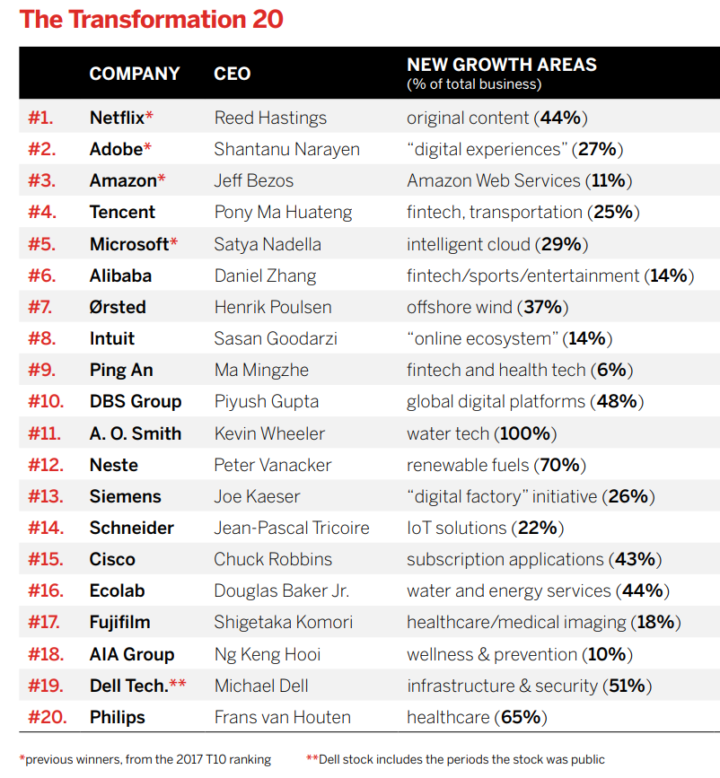We are now beginning to see businesses invest more on their change management processes to provide them the flexibility they need in these ever-changing times. This is a great outcome, however businesses should have the ability to swiftly refine and reinvent regardless of a global pandemic or not. And the key to these reinventions is people.
The need to reinvent your products and services
Products and services that are currently the cash cow may not exist by the time we turn over to the next decade, or in some cases, by the time we turn over to the next year.
Below are some illustrative examples of businesses that are well-oiled, agile machines, and businesses that perhaps didn’t reinvent themselves quickly enough:
- Amazon transitioned from an online book shop to the no. 1 global fresh food service, or Datacentre provider, if you look at it from another angle.
- Philips is regularly evaluating its business and creating new products that are addressed to several different consumer types across different markets, ranging from beard trimmers to cardiograph machines. I wonder if it stuck to selling light bulbs like it set out in the 1900s if it would be the company it is now.
- Kodak has currently brought itself back from the dead and reinvented itself as an innovative blockchain platform for photographers.
- Blockbuster is on the other end of the spectrum where it did not reinvent itself quickly enough and currently withers on with only one store left open in the entire world.
Furthermore, companies that were traditionally leaders in one field have re-evaluated their businesses in order to survive and reinvented themselves and emerged as leaders in entirely different areas from their historical business objectives and services, as illustrated below:
Data gathered by Innosight.
Reinventing isn’t always a success
It’s very easy to review the above as a spectator and raise our glass to them, but transformation isn’t an easy task, and notably, businesses that succeed in reinventing themselves are barely 16% of those that tried in the first place, while the other 84% failed according to data collected by Forbes. Whilst deciding to reinvent a company is a challenge within its own right, conducting the transformation successfully is really where the challenge begins—examples of companies that were not able to execute reinventions successfully include Blackberry, Xerox and MySpace.
Transformations are very complex programmes and strategies, and they all come in different shapes and sizes, but they all share the same ingredient—people. Without employees to support the company’s initiative, transformation will never be met with success, and the only way to do this is to bring onboard employees and take them on the journey with the company.
How to take your employees on the journey with you
Below are several ways in which a company can learn from failure and engage employees to successfully execute a transformation programme and strategy:
| Where many of the 84% go wrong | The right approach to bring them on the journey | How you can go about doing this | |
| 1 | Inform their employees of the programme the company is about to launch | Show the employees how the current setup is no longer working for the business, not once, but regularly throughout the transformation programme | Show them sales which may be on a downward trend, or direct competitors that are currently thriving in new markets |
| 2 | Lacking clear targets | Define the exact targets the business is trying to reach | Set realistic profit margins, or new product launches or services to be available before a certain time period |
| 3 | Many employees break away during the transformation | Ensure all employees remain engaged through every stage of the journey | Provide various strategies to animate all audiences through various approaches. These can be:
1. Poll questions to capture feedback |
| 4 | Training is treated as a tick box exercise rather than a programme | Employees need to be taken on their own transformation journey to upskill. Sending them on a day’s course is not enough | A structure training programme needs to be setup which will provide employees different approaches to suit their learning needs, provide them a chance to learn at their own pace, and keep practising their knowledge until its time to put it to good use |
| 5 | Many methodologies such as the waterfall approach only deliver results at the end. By that point many of your employees would have lost interest, particularly if it is an 18-month or longer transformation programme | Ensure the methodology enables employees to regularly see results and changes that will keep them motivated | An Agile iterative approach sees changes being delivered on a regular basis which helps to keep the organisation interested, as well as enables the business to remain competitive while the transformation is under way |
| 6 | The transformation is managed internally | Transformation programmes need specialist knowledge and expertise | Bring onboard a Change Management consultancy that has tried and tested practises and tools |
Final Thoughts
Harvard Business Review calls the ability to transform “The Competitive Strategy” and is something businesses will need to do time and time again. Chances are before a business fully completes one transformation, the need to transform again may not be as far away as a business may think. The important thing is to understand the art of bringing employees on a shared journey, and after a business has mastered the art, the transformation itself may not be as daunting as it originally seemed.




